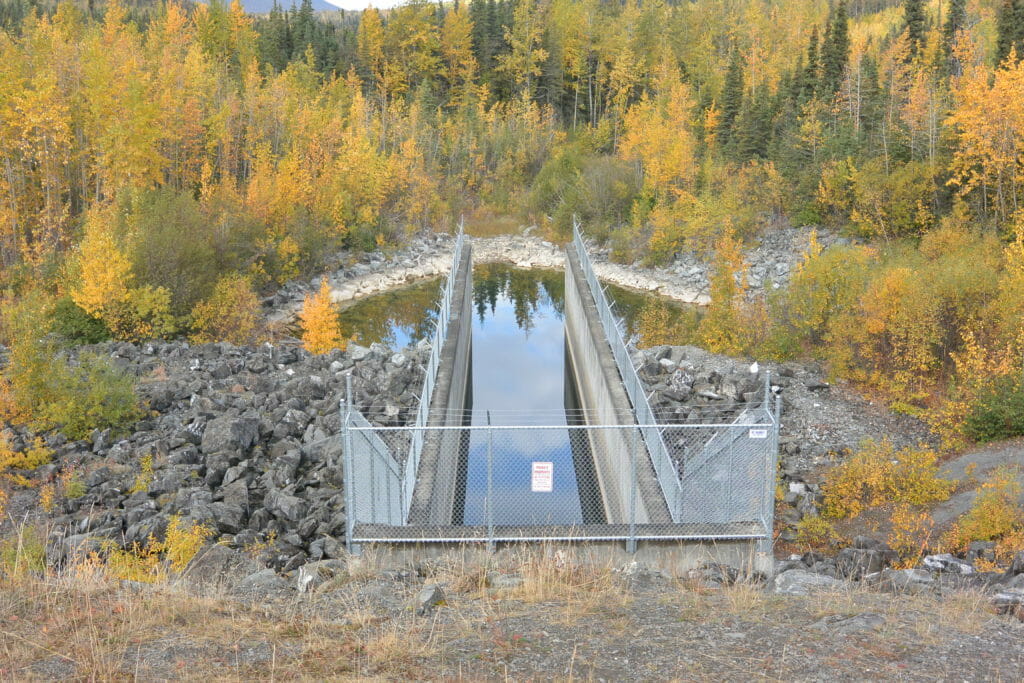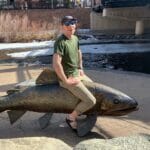It felt wrong to be sitting in the middle of the dry riverbed eating my lunch.
I sat in the exact spot where the Eklutna River should have begun its gravity fueled descent out of the Eklutna Lake, meandering the ancient glacial valley and carving an exquisite canyon. It did so until roughly seven decades ago. In 1955 when the Upper Eklutna Dam was built, it choked off the outlet of the lake, starving the river of water.

In my mind, this semi flat rock shouldn’t be a comfortable option for me to enjoy my chicken salad. In fact, I’d prefer if I didn’t have the opportunity to eat my lunch here at all, and soon hopefully the choice will be off the table, so to speak. In the coming years, this spot could well be submerged in water again. That’s the goal, at least.
With a looming deadline to mitigate the impacts to fish and wildlife resulting from the Eklutna Hydropower Project, I took a field trip to the Eklutna Watershed. Over the past four years, I have visited this magnificent area numerous times. I observed the dismantling of the abandoned lower Eklutna Dam that stood in the path of migratory salmonids for nearly a century with excitement. I have enjoyed weekends of solitude and quick escapes with friends and family while snowshoeing to public-use cabins, hiking and ice skating. And I’ve stood atop the 41-foot Upper Eklutna Dam, staring down at the barren riverbed, more than and handful of times.
As an angler, this is where the problem sinks in. It’s a visible focal point for the issue at hand. On one side, a massive freshwater lake, on the other, a salmon stream that once supported all five species of Pacific salmon sits bone dry.
With majority of the water in the lake reserved for creating a small amount of hydropower, and the rest allocated for Anchorage’s drinking water and a small bottled water company, the level of the lake varies dramatically based off season and precipitation. Frequently there are dozens of yards of dry lakebed spanning between the waterline and the vegetation. On occasion the lake nears full, encroaching on the shoreline and inching its way up the Upper Eklutna dam, designed to capture the fullest natural extent of the lake, and then some. Currently, the lake is pushing the limits of the dam.
Over the past several years, I’ve learned a lot about the history of the Eklutna River, the current usage of its valuable water, and what it will take to return the river to a heathy and productive state. Nearing the last bite of my chicken salad, it’s difficult not to return to what I don’t know and the two questions being considered by many: How much water do salmon need in order to access and utilize the newly connected habitat to the fullest extent? How will water be returned to the river while continuing to fulfill all of the Eklutna Lake water users’ needs.
Returning the remainder of lunch to my backpack and standing up with a stretch, I resolve that these are the questions I am thankful a hive of more technical minds is also considering. Scrambling back up the dam and surveying the nearly “full” lake below the rip-rap face of the embankment dam, I catch the impetus of a ring, slowly growing on the lake’s glassy surface, out of the corner of my eye. The telltale sign of a hungry fish in a lake not known for its fishing.
“What kind of fish is it?” The question any angler would ask, echoed through my cranium. I may not have all the answers for the future of Eklutna River yet, but this is a question I am well suited to get to the bottom of today.
Belly now full, I return to my car to fetch the resident 3-weight. I am of the belief to “always bring a fly rod.” It’s always better to have one and not need it than need it than not have it, a lesson I have learned the hard way. It only took a few quick casts before my slowly stripped woolly bugger was crushed by a chrome Dolly Varden.
Mystery solved.
Eric Booton is the sportsmen’s outreach coordinator for TU’s Alaska Program. He lives and works in Anchorage.



